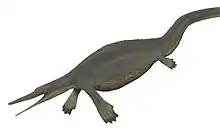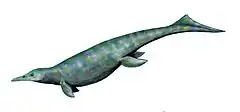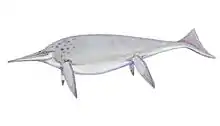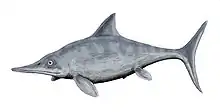Cymbospondylus
Cymbospondylus (a Greek word meaning "boat spine") was a basal early ichthyosaur that lived between the middle and later years of the Triassic period (240-210 million years ago). Previously, the genus was classified as a shastasaurid, however, more recent work finds it to be more basal.[2]
| Cymbospondylus | |
|---|---|
 | |
| C. buchseri fossil | |
| Scientific classification | |
| Kingdom: | Animalia |
| Phylum: | Chordata |
| Class: | Reptilia |
| Order: | †Ichthyosauria |
| Family: | †Cymbospondylidae |
| Genus: | †Cymbospondylus Leidy, 1868 |
| Type species | |
| †Cymbospondylus piscosus Leidy, 1868 | |
| Other species | |
| |
Discovery
Fossils have been found in the Germanic Basin southern alps and Nevada, and the first species was named by Joseph Leidy in 1868. It was not until the early 1900s that the first complete skeletons were discovered.
So far, the valid species are the type species C. piscosus, C. buchseri, C. nichollsi and C. duelferi.[1] Other species are declared either as synonyms (C. grandis is a synonym to C. piscosus) or as doubtfully valid.
Palaeobiology

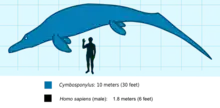
Cymbospondylus was one of the largest ichthyosaurs, with fossils ranging from 6 to 10 metres (20 to 33 ft) long.[3] It was also one of the least fish-like of the ichthyosaurs, lacking a dorsal fin. It did, however, have an elongated snout like other ichthyosaurs.[4]
The one metre long head of Cymbospondylus,[3] with large jaws, contained rows of teeth adapted for catching and holding on to fish and cephalopods such as ammonites and belemnites. The long tail would have been excellent for swimming, and allowed Cymbospondylus to move at fast speeds and efficiently hunt down shoals of swimming fish.
Adult Cymbospondylus probably spent much of their time hunting in deep offshore water, only venturing into shallower water to breed or to catch seasonally available prey. Like other ichthyosaurs, Cymbospondylus probably gave birth to live young, as it had no way to lay eggs.[3] These, on reaching adult size, probably had few, if any, predators that could harm them.
The eel-like tail of Cymbospondylus made up almost half the total body length, and it is possible that the tail was used as a primary swimming mechanism. Like present day sea snakes, Cymbospondylus probably swam by wriggling its body from side to side. The paddle-like limbs of Cymbospondylus would primarily have been underwater stabilizers, and for slowing down the ichthyosaur's swimming speed.[4]
References
- Nicole Klein; Lars Schmitz; Tanja Wintrich; P. Martin Sander (2020). "A new cymbospondylid ichthyosaur (Ichthyosauria) from the Middle Triassic (Anisian) of the Augusta Mountains, Nevada, USA". Journal of Systematic Palaeontology. Online edition (14): 1167–1191. doi:10.1080/14772019.2020.1748132. S2CID 219078178.
- Motani, R. 1999: Phylogeny of the Ichthyopterygia. Journal of Vertebrate Paleontology. 19 (3): 473 – 496
- "Cymbospondylus". BBC – Science & Nature. Retrieved 25 May 2009.
- Palmer, D., ed. (1999). The Marshall Illustrated Encyclopedia of Dinosaurs and Prehistoric Animals. London: Marshall Editions. p. 78. ISBN 1-84028-152-9.
Fröbisch, N., Sander, P. and Rieppel, O. 2006: A new species of Cymbospondylus (Diapsida, Ichthyosauria) from the Middle Triassic of Nevada and a re-evaluation of the skull osteology of the genus. Zoological Journal of the Linnean Society 147:515-538.
Sander, P. 1992: Cymbospondylus (Shastasauridae: Ichthyosauria) from the Middle Triassic of Spitsbergen: filling a paleobiogeographic gap. Journal of Paleontology 66:332-337.
Sander, P. 1989: The large ichthyosaur Cymbospondylus buchseri, sp. nov., from the Middle Triassic of Monte San Giorgio (Switzerland), with a survey of the genus in Europe. Journal of Vertebrate Paleontology 9:163-173
